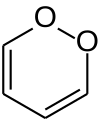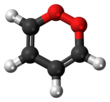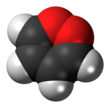1,2-Dioksin
1,2-Dioxin adalah senyawa heterosiklik, organik, antiaromatik dengan rumus kimia C4H4O2. merupakan isomer dari 1,4-dioxin (atau p-dioxin).

| |||
| |||
| Nama | |||
|---|---|---|---|
| Nama IUPAC (sistematis)
1,2-Dioxine[1] | |||
| Penanda | |||
Model 3D (JSmol)
|
|||
| 3DMet | {{{3DMet}}} | ||
| ChemSpider | |||
| Nomor EC | |||
PubChem CID
|
|||
| Nomor RTECS | {{{value}}} | ||
CompTox Dashboard (EPA)
|
|||
| |||
| |||
| Sifat | |||
| C4H4O2 | |||
| Massa molar | 84,07 g·mol−1 | ||
| Senyawa terkait | |||
Senyawa terkait
|
Dibenzodioxin | ||
Kecuali dinyatakan lain, data di atas berlaku pada suhu dan tekanan standar (25 °C [77 °F], 100 kPa). | |||
| Referensi | |||
Mengingat karakteristiknya yang mirip peroksida, 1,2-dioxin sangat tidak stabil dan belum berhasil diisolasi. Bahkan derivat penggantinya juga sangat labil, misal 1,4-difenil-2,3-benzodioxin.[2] Pada tahun 1990, 3,6-bis(p-tolyl)-1,2-dioxin salah diakui sebagai derivat pertama yang stabil.[3] Akhirnya diketahui bahwa senyawa tersebut bukan derivat dari 1,2-dioxin, tetapi secara termodinamika lebih stabil daripada dione.[4]
-
The isomers 1,2-dioxin (left) and 1,4-dioxin (right)
-
Structure of the transient 1,4-diphenyl- 2,3-benzodioxin
-
Dioxin (1) and dione form (2)
Referensi
- ^ "CID 15559065 - Compound Summary". PubChem Compound. USA: National Center for Biotechnology Information. 12 February 2002. Identification and Related Records. Diakses tanggal 7 October 2011.
- ^ J. P. Smith, A. K. Schrock, G. B. Schuster: Chemiluminescence of organic peroxides.
- ^ H. J. Shine, D. C. Zhao: Electron transfer to excited doublet states.
- ^ E. Block, Z. Shan, R. S. Glass, J. Fabian: Revised structure of a purported 1,2-dioxin: a combined experimental and theoretical study, J. Org.
| This article about a heterocyclic compound is a stub. You can help Wikipedia by expanding it. |




